It can stretch a pound of ground beef to feed a family of five and make supermarket cheese into something sublime. If you grew up in the 1960s and ’70s, it may have been dinner, more often than not. This familiar friend is the casserole, of course, that distinctly American culinary genre that despite being maligned by food snobs, has never fully gone out of favor.
In fact, like almost everything mid-20th century, casseroles are hot (pun intended). Recipes for modernized versions of shepherd’s pie and Southern-style chicken casserole appear in high-end food magazines, while healthy lifestyle publications include “lightened up” takes on the calorie-rich classics.
In Austin, Texas, the “Casserole Queens” are two friends who have built a successful brand from home delivery to best-selling cookbooks and TV appearances. Their recipes mostly feature fresh ingredients, bringing today’s casseroles closer to their roots.
Cooking “en casserole” – a French phrase that refers both to the method of combining several ingredients in one pot and the pot itself – dates to at least the early 18th century. Long, slow roasting turned tough cuts of meat and vegetables into a tasty meal, which went from oven to table in the same dish.
Beginning in the early 1940s, the Campbell’s Soup Company is credited with popularizing “modern” casseroles such as tuna noodle; these were easy on the cook because cream soups could be swapped in for a time-consuming sauce. By the mid-1950s, these casseroles were a boon for women who, whether or not they worked outside the home, were increasingly uninterested in spending hours in the kitchen. Canned soup and other newly available convenience foods were liberating, and the world was not yet aware of health issues caused by sodium or fat content.
If money and time were tight, casseroles eased the way. My mother, who entered the workforce after her three children were in school in the mid-1970s, relied on a rotating, budget-friendly repertoire that included tuna noodle (my favorite, with its crunchy topping of crumbled potato chips), macaroni and cheese (always melty Velveeta), American chop suey and something called “Texas hash.” With the addition of a salad or steamed frozen vegetables, dinner was done.
Christine Burns Rudalevige of Brunswick did not grow up on casseroles. “My Italian-Irish father thought lasagna was a side dish,” she says. But for her husband, the son of a Methodist minister, “casseroles and Jell-O molds are his comfort foods.”
Rudalevige, a recipe developer for Cooking Light magazine, cookbook recipe tester, food writer and chef instructor/culinary lead at Stonewall Kitchen in York, Rudalevige is not about to make a casserole with canned soup or frozen peas. But with a busy professional life, and as the mother of Eliza, 12, and Owen, 15, one-dish meals are often on her table.
“To balance the two upbringings and help appease my foodie self, I have developed a couple of staples,” she said.
Among them, her No-Noodle Vegetable and Turkey Lasagna is a family favorite.
“When I grill vegetables I go out to the grill and do a big platter of them to eat all week,” she explains. “But I wanted to do something different … I thought, can we do a veggie lasagna and make these the noodles? We needed to add more protein, so we put some turkey in it.”
Rudalevige likes to use eggplant and zucchini, but depending on the season, the “noodles” might be butternut squash or peppers – “anything that you can cut round and flat and grill,” she says.
The dish is rich and cheesy, with ricotta, fresh mozzarella and Parmesan, and gets an extra boost of nutrition from chopped kale.
While acknowledging that well-crafted casseroles can be “elevated to dinner party status … centerpieces themselves instead of just a weeknight meal,” Rudalevige cautions that making these one-dish wonders without convenience foods is considerably more involved.
“I think that when you start with fresh ingredients, I’m not going to lie, it is a little harder than opening up cans,” she says. “You’re still going to have to spend some time on the weekend going to the market, getting the ingredients. It’s not going to be one of those things that you come home at 5 p.m., get a glass of wine, do the soccer run and then sit down to eat.”
Asked for her expert advice on building a better casserole, Rudalevige is quick to point out that without salt-laden convenience foods, proper seasoning is key.
“Where people fall down, I think, is that they put all the flavor in the sauce. You have to season it as you go along; season the meat, the vegetables and the sauce. It’s something we try to drill in at Stonewall: If you season at the end, it becomes too salty. If you season as you go, you get better flavor.”
Rudalevige is a stickler for flavor, but not a DIY purist. You don’t have time to grill all of those veggies? Head for the prepared food counter at the supermarket.
“I’ve been known to go to the Whole Foods counter and say yes, I need 10 pieces of grilled eggplant,” she says.
For cookbook author Dana Moos of Southwest Harbor, who also teaches at Stonewall Kitchen, the go-to casserole is her mother’s Creamy Curry Chicken Divan.
“My mom would make it the classic way, using frozen broccoli and dry bread crumbs and to this day, she still makes it when my parents have extended-family dinners,” Moos says. “But over the years I’ve changed it up a bit, roasting the chicken, using fresh roasted broccoli and then adding roasted shallots as well.”
The original recipe calls for cream of chicken soup, which Moos says she has replaced, on occasion, with a sauce made from chicken broth and a butter and flour roux.
“But I usually save that effort for my chicken pot pie,” she admits. “Sometimes a can of soup in a casserole is just what comfort food from our childhood requires!”
Now that fall is fully upon us, it’s definitely casserole weather. Cozy up with Rudalevige’s take on lasagna, Maine gardening guru Barbara Damrosch’s Kale and Potato Casserole or Moos’ old-school chicken dish.
“Casseroles are like a big hug,” says Rudalevige. “It’s like: ‘Here, I’ve made this for you and you’re going to want a nap afterwards.’ ”
NO-NOODLE VEGETABLE AND TURKEY LASAGNA
Courtesy of Christine Burns Rudalevige
Serves 9-12.
2 tablespoons butter
4 ounces sliced mushrooms
2 cups chopped kale
2 tablespoons olive oil
1 cup onions, diced
3 garlic cloves, minced
1/2 pound ground turkey
2 cups tomato puree
2 cups ricotta cheese
1 egg
1/4 cup chopped fresh herbs (parsley, oregano, thyme)
1/4 cup grated pecorino Romano cheese
Salt and pepper
30 slices of grilled vegetables such as eggplant, zucchini, butternut squash, summer squash and/or red peppers.
8 ounces fresh mozzarella cheese
Melt butter in a heavy skillet over medium high heat. Add mushrooms and stir to coat. Leave the mushrooms alone for 3 to 4 minutes until the undersides are caramelized. Stir in chopped kale and season with salt and pepper. Pour mixture into a bowl. Set aside.
Put skillet back on the heat, and add oil and onions. Saute them for 3 minutes and stir in garlic. Cook mixture for 30 seconds and add turkey, breaking it into pieces as it cooks. Once the meat is no longer pink, add puree and simmer the sauce for 10 minutes. Season with salt and pepper. Set aside.
In a small bowl combine ricotta, egg, herbs and pecorino. Season with pepper. Set aside.
Preheat oven to 325.
In a large baking dish, spread 1 cup of sauce. Lay down one layer of vegetables (I like to start with eggplant). Tear mozzarella into small pieces and scatter half of it over the top of the first layer. Then spread the mushroom and kale over the cheese.
Lay down the second layer of vegetables and spread the ricotta cheese mixture over them. Top with the last layer of vegetables and spoon the remaining sauce over the top. Cover with foil and bake the casserole for 45 minutes. Crank heat to 425. Remove the foil, sprinkle the remainder of the mozzarella cheese on top. Let it finish baking at high heat, taking it out of the oven when the cheese has melted and has browned a bit.
Let the casserole sit on the counter for 15 minutes before cutting into it.
CREAMY CURRY CHICKEN DIVAN
Courtesy of Dana Moos
Serves 5-6.
This has been one of my most favorite comfort food casseroles for probably 25 years or so. It’s my adaptation of my mom’s recipe. And FYI, this is great leftover!
I use a 9×9 deep baking dish, but you can use the 9×12 classic baking dish.
4 half chicken breasts, split in half (through the thickness of the chicken)
2 medium broccoli crowns (or one large head of broccoli), cut into florets
5 medium shallots, each sliced into 3 to 4 rounds
1 can cream of chicken soup
1/4 cup chicken broth
1 cup mayonnaise
3/4 cup sour cream
1/4 teaspoon salt
1/8 teaspoon pepper
1/4 teaspoon onion powder (or granulated)
1 teaspoon brown sugar
11/2 teaspoons yellow curry powder
Olive oil for roasting the chicken and veggies
TOPPING
12 ounces shredded cheddar (I use a mix of yellow and white)
1 cup panko bread crumbs
2 tablespoons butter, melted with 1 tablespoon olive oil and 1/8 teaspoon curry powder
Heat the oven to 400.
On a rimmed baking sheet, add the chicken breast pieces, dust with a pinch of salt, pepper and curry powder, drizzle with olive oil and roast for 20 minutes.
On another sheet pan, add broccoli and shallots, dust with a pinch of salt and drizzle with olive oil and roast until the shallots turn light brown, about 20 minutes.
Let both pans cool while preparing the rest of the dish.
Mix the soup, mayo, sour cream, chicken broth, salt, pepper, onion powder, brown sugar and curry powder until well combined.
To assemble the casserole: first, layer the chicken breasts on the bottom of the baking dish, then add the broccoli, then the shallots, scattering both evenly. Pour the creamy mixture over top, covering the ingredients. Top with the shredded cheddar, then the panko crumbs, and last, drizzle the butter over the crumbs.
At this point, you could refrigerate until ready to bake, and you could prepare this the night before. Just let sit at room temperature before baking.
Bake at 350 for about 45 minutes, until the edges bubble and the top has lightly browned.
POTATO AND KALE CASSEROLE
Reprinted with permission from “The Four Season Farm Gardener’s Cookbook” by Barbara Damrosch and Eliot Coleman
Serves 4 as a main dish, 6 as a side dish.
Although similar to scalloped potatoes, this casserole has enough vegetables in it to be a complete meal. We like it on fall or winter evenings, along with a bowl of raw, sweet, crisp winter carrots.
8 small potatoes (any type), unpeeled, sliced into thin rounds (about 4 cups)
Freshly ground black pepper
5 ounces feta cheese, chopped or crumbled
11/2 cups heavy (whipping) cream
10 scallions (white and green parts), chopped (about 2/3 cup)
12 sprigs flat-leaf parsley (leaves and upper stems), coarsely chopped (about 1/2 packed cup)
8 small to medium-size Tuscan kale leaves, ribs removed, leaves coarsely chopped (about 11/4 loosely packed cups)
3 ounces Parmesan cheese, preferably Parmigiano-Reggiano, finely grated (1/3 cup)
Preheat the oven to 400.
Spread half of the potatoes over the bottom of a 9 by 13-inch baking dish, overlapping them. Grind pepper over them generously. Distribute half of the feta over the potatoes. Slowly pour 3/4 cup of the cream over the top. Sprinkle with half of the scallions, half of the parsley and half of the kale.
Repeat the layers: the rest of the potatoes, a grinding of pepper, and the rest of the feta, cream, scallions, parsley and kale.
Sprinkle the Parmesan cheese uniformly over the top.
Cover the baking dish loosely with aluminum foil or parchment paper (so steam can escape), and bake for 30 minutes. Remove the foil and bake until the Parmesan is lightly browned and most of the cream has been absorbed and does not run into a corner when the dish is tilted, 5 to 10 minutes.
Let the dish cool for 5 minutes before serving.
This is also good made with sharp Cheddar and/or Gruyere.
Staff Writer Susan S. Axelrod may be contacted at:saxelrod@mainetoday.com
Send questions/comments to the editors.

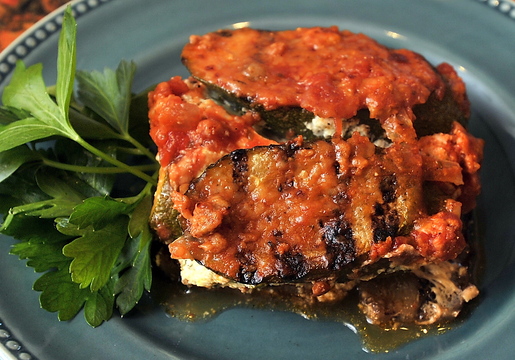
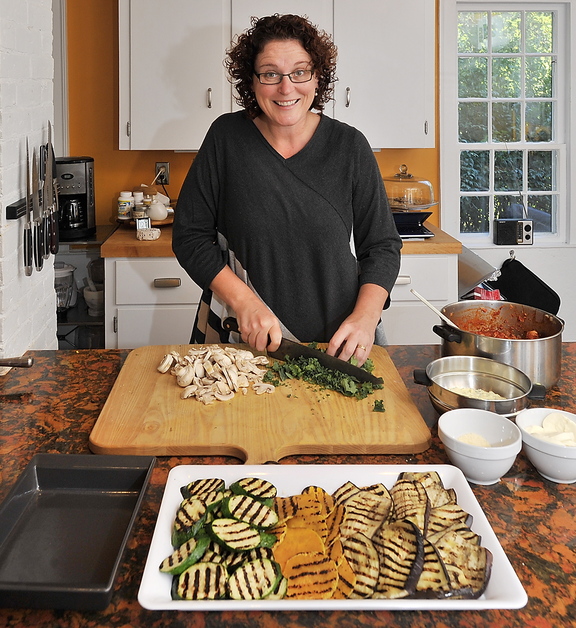
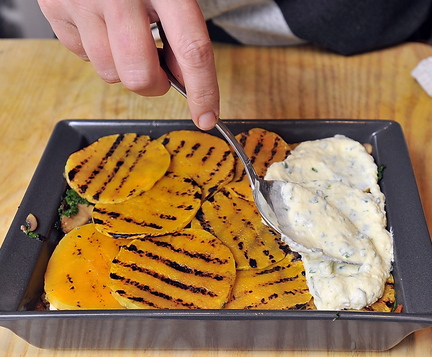
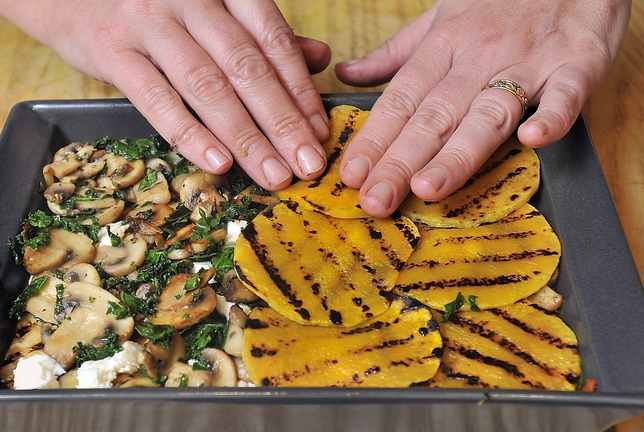
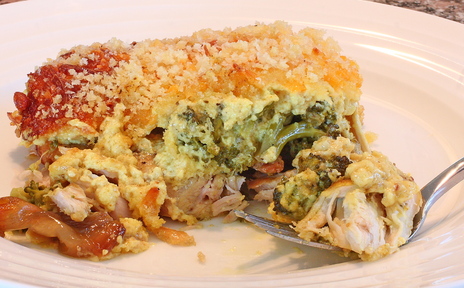

Comments are no longer available on this story